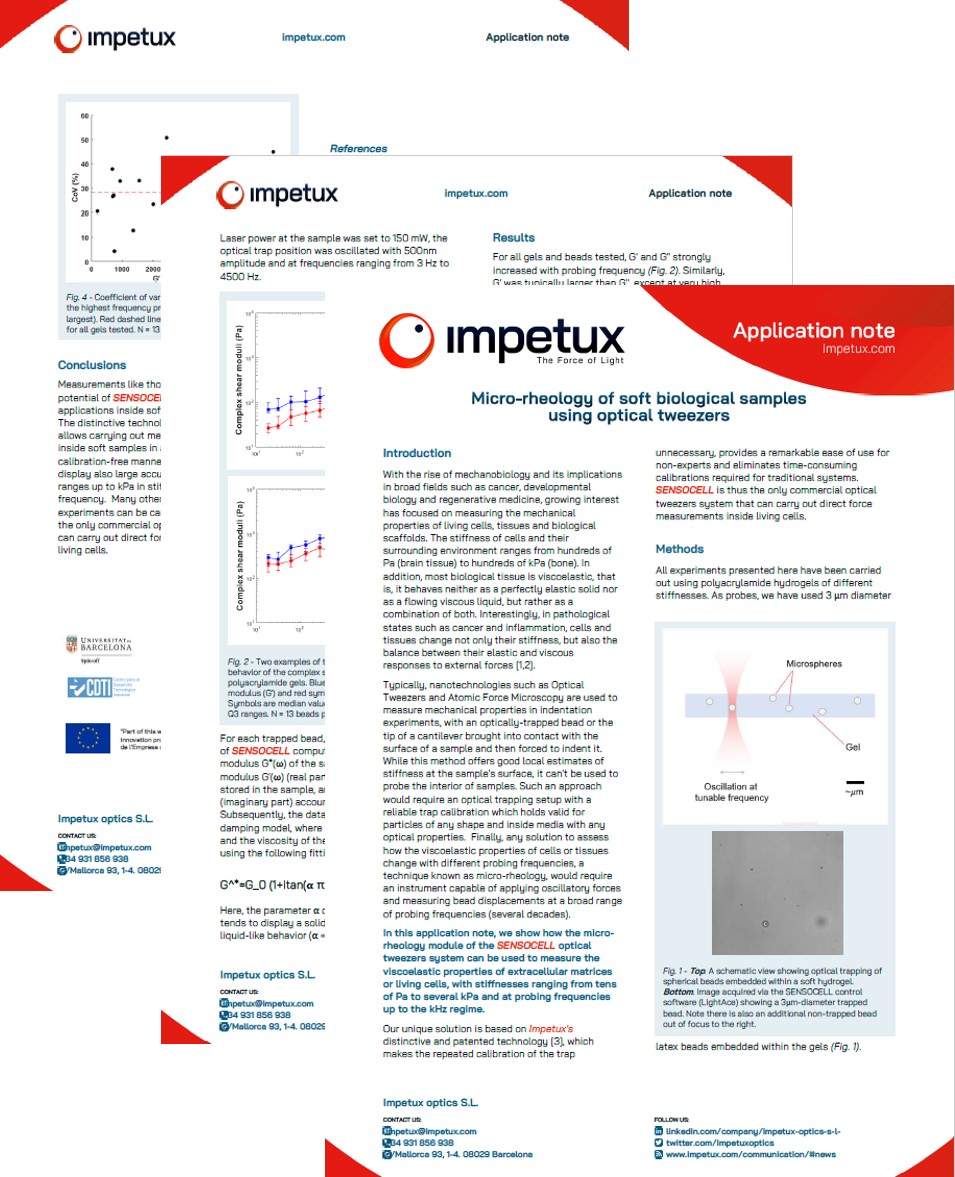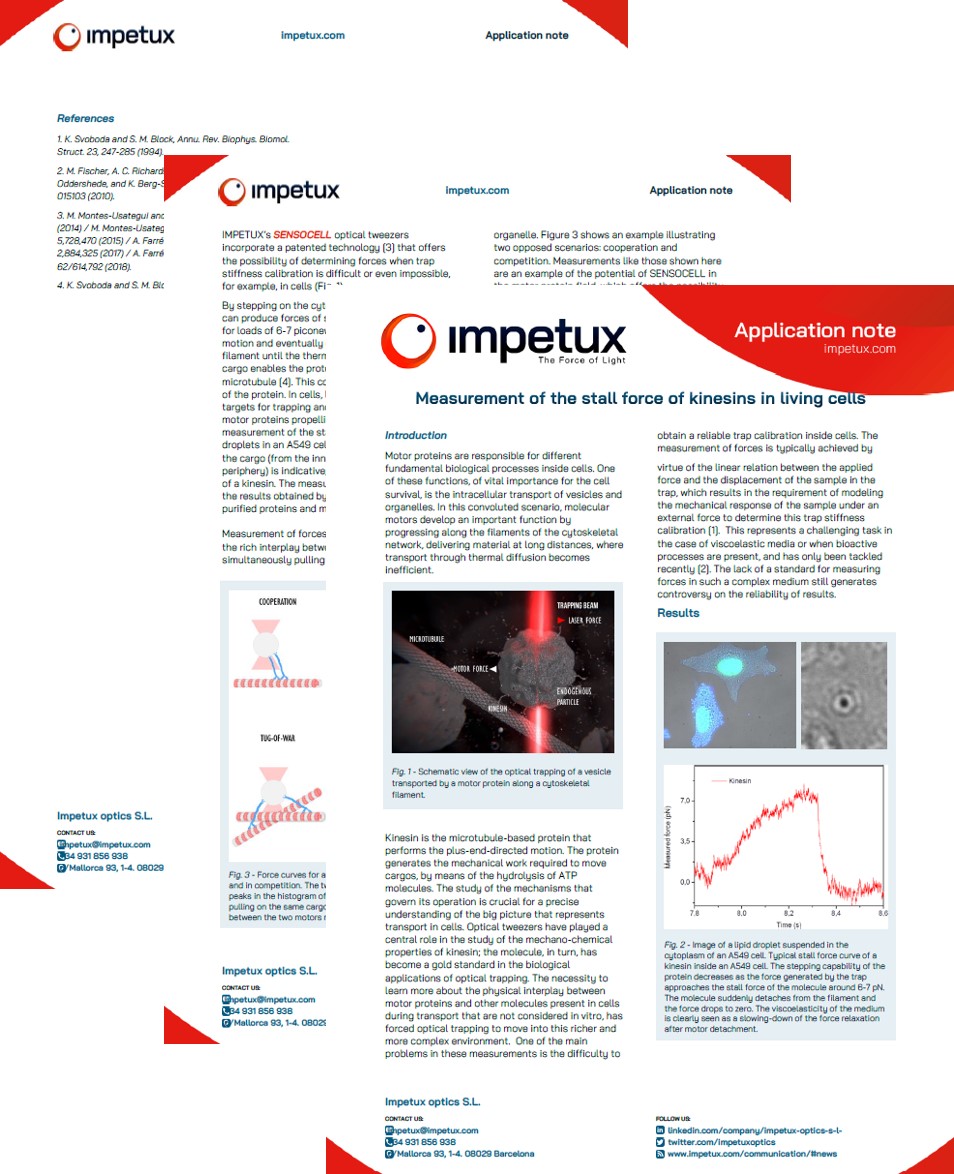Scientific Publications related with optical tweezers
A wide optical tweezers review from different points of view.
Scientific Publications from IMPETUX’s customers:
Bellow you will find a wide optical tweezers review for different applications with the latest publications with impressive examples and results obtained with our systems:
July 2024
Nanoscopic wetting behaviour of single oil droplets on a fibre
Ophelie Squillace, Ting Zhang, Lia Argentou, Andrew Ward, Zhenyu J. Zhang
Colloids and Surfaces A: Physicochemical and Engineering Aspects: https://doi.org/10.1038/s41556-023-01247-0
A new work using our Lunam Force Sensor led by UK researchers (from the University of Birmingham and the Central Laser Facility at the Rutherford Appleton Laboratory) has been published in Colloids and Surfaces A Journal.
You can find the published article here.
Our sensor was used to measure silicone droplets-microfiber interactions. Researchers used our Lunam Force Sensor to quantify the surface interaction and wetting of liquid droplets on microscopic fibres.
October 2023
A MEC-2/stomatin condensate liquid-to-solid phase transition controls neuronal mechanotransduction during touch sensing
Neus Sanfeliu-Cerdán, Borja Mateos, Carla Garcia-Cabau, Frederic Català-Castro, Maria Ribera, Iris Ruider, Montserrat Porta-de-la-Riva, Stefan Wieser, Xavier Salvatella, Michael Krieg
Nature Cell Biology -2023: https://doi.org/10.1038/s41556-023-01247-0
This recently published in Nature Cell Biology study reveals the mechanism by which MEC-2 protein condensates in touch receptor neurons can change from a liquid to a solid-like state. This transition alters their role in transmitting mechanical forces. The study, conducted by researchers from ICFO and IRB Barcelona, focuses on the importance of understanding these transitions in protein condensates to develop innovative therapies and treatments. THe IMPETUX's Optical tweezers system SENSOCELL was used to study the mechanical properties of the purified protein condensates and investigate how they change over time.
You will find a wide and interesting explanation on the findings and implications at the ICFO website: here
You can also find the published article here.
October 2023
Mechanical stress confers nuclear and functional changes in derived leukemia cells from persistent confined migration
Ana de Lope-Planelles, Raquel González-Novo, Elena Madrazo, Gracia Peralta-Carrero, María Pilar Cruz Rodríguez, Héctor Zamora-Carreras, Verónica Torrano, Horacio López-Menéndez, Pedro Roda-Navarro, Francisco Monroy & Javier Redondo-Muñoz
Cellular and Molecular Life Science: https://doi.org/10.1007/s00018-023-04968-5
In this work, the authors discuss the importance of nuclear deformability in cell migration. They analyze how persistent migration through physical barriers can lead to permanent changes in cell behavior and nuclear structure. Their findings suggest that mechanical compression during persistent cell migration may contribute to stable nuclear and genomic alterations, potentially influencing genetic instability and cellular heterogeneity in aging diseases and cancer.
You will find the article here.
October 2023
Time-shared optical tweezers for active microrheology inside cells
Frederic Català-Castro, Paolo Antonio Frigeri, Santiago Ortiz-Vásquez, Carmen Martínez-Fernández, Michael Krieg
Proceedings Volume 12649, Optical Trapping and Optical Micromanipulation XX; 126490N (2023) https://doi.org/10.1117/12.2681989
Event: SPIE Nanoscience + Engineering, 2023, San Diego, California, United States
In this presentation the authors discuss the use of non-invasive, optical tweezers active microrheology to gain insights into the mechanobiological principles governing cellular processes
You will find the conference presentation here.
September 2023
The laminin-keratin link shields the nucleus from mechanical deformation and signaling
Zanetta Kechagia, Pablo Sáez, Manuel Gómez-González, Martín Zamarbide, Ion Andreu, Thijs Koorman, Amy E.M. Beedle, Patrick W.B. Derksen, Xavier Trepat, Marino Arroyo, Pere Roca-Cusachs
Nature Materials: https://doi.org/10.1101/2022.03.01.482474
In this work, the labs of Pere Roca-Cusachs and Xavier Trepat (IBEC, Barcelona) investigate how the rigidity of a laminin based extracellular environment influence mechanotransduction in mammary epithelial cell models.
You will find the article here.
January 2023
Persistent confined migration confers permanent nuclear and functional changes in migrating cells.
Ana de Lope-Planelles, Raquel González-Novo, Elena Madrazo, Héctor Zamora-Carreras, Verónica Torrano, Horacio López-Menéndez, Pedro Roda-Navarro, Francisco Monroy, Javier Redondo-Muñoz
doi: https://doi.org/10.1101/2023.01.05.522838
Highlights
Persistent confined migration promotes permanent mophological changes.
Lamin B1 is redistribution in the nucleus of migratory altered cells.
Migratory-altered cells exhibit transcriptional and functional changes related to cell migration and survival.
Actin polymerization controls nuclear changes induced by cell migration.
This article is a pre-print, and you will find it here
May 2022
Osanger regression characterizes living systems in passive measurements
Till M. Muenker, Gabriel Knotz, Matthias Krüger, Timo Betz
doi: https://doi.org/10.1101/2022.05.15.491928
This article is a pre-print, and you will find it here
April 2022
Nonequilibrium fluctuations and nonlinear response of an active bath
Hunter Seyforth, Mauricio Gomez, W. Benjamin Rogers, Jennifer L. Ross, Wylie W. Ahmed
Phys. Rev. Research 4, 023043 (April 2022)
In this work, Dr Ahmed ( leader of the Laboratory for Soft, Living, and Active Matter) et al., analyze the dynamics of a passive colloidal probe immersed in an active bath using Optical tweezers in combination with our force spectroscopy technology .
If you are interested in soft condensed matter and nonlinear rheology have a look at it.
You will find the article here.
March 2022
Video Protocol for Direct Force Measurements of Subcellular Mechanics in Confinement using Optical Tweezers
Frederic Català-Castro, Valeria Venturini, Santiago Ortiz-Vásquez, Verena Ruprecht, Michael Krieg
JoVE Journal: DOI: 10.3791/62865-v
Here, the authors present a protocol to investigate the intracellular mechanical properties of isolated embryonic zebrafish cells in three-dimensional confinement with direct force measurement by an optical trap.
If interested in intracellular and nuclear mechanics, have to look at it here.
October 2021
Intracellular softening and increased viscoelastic fluidity during division
Sebastian Hurst, Bart E. Vos, Matthias Brandt & Timo Betz
Nature Physics (2021). https://doi.org/10.1038/s41567-021-01368-z
In this work, the authors use optical tweezers to show intracellular softening, fluidification and decrease of active forces in mitosis that is mediated by a surprising role switch between microtubules and actin.
Impetux's force sensor is used to measure the cytoplasm's fluidity and stiffness changes of dividing cells.
It is the first time that the cell mechanics is characterized during mitosis from the inside
September 2021
An asymmetric mechanical code ciphers curvature-dependent proprioceptor activity
Ravi Das, Li-Chun Lin, Frederic Català-Castro, Nawaphat Malaiwong, Neus Sanfeliu, Montserrat Porta-de-la-Riva, Aleksandra Pidde, Michael Krieg.
SCIENCE ADVANCES 17 Sep 2021 Vol 7, Issue 38 DOI: 10.1126/sciadv.abg4617
In this work, the mechanical activation of neuronal activity in C. elegans is studied by means of genome editing, modelling and direct force spectroscopy integrated in SENSOCELL optical tweezers. The system is also combined with spinning-disk confocal microscopy to monitor Ca2+ ion channel dynamics during axon membrane tether extrusion experiments.
August 2021
Direct Force Measurements of Subcellular Mechanics in Confinement using Optical Tweezers - JOVE protocol.
Frederic Català-Castro, Valeria Venturini, Santiago Ortiz-Vásquez, Verena Ruprecht, Michael Krieg.
J. Vis. Exp.(174), e62865, doi:10.3791/62865 (2021).
In this article, the authors describe in detail a new method and protocol using SENSOCELL optical tweezers to measure the forces and material properties that shape the cell nucleus inside living cells, exemplified on adherent cells and mechanically confined cells.
According to the authors,
The presented method is straightforward and can easily be extended to investigate the mechanics of other subcellular compartments, e.g., mitochondria, stress-fibers, and endosomes.
To deepen into the details of this protocol and look at the representative results shown, you can read the full article here.
For additional information, have a look at:
Our Customer Story.
Our Nucleus Mechanics Application page.
July 2021
The force loading rate drives cell mechanosensing through both reinforcement and fluidization
Ion Andreu, Bryan Falcones, Sebastian Hurst, Nimesh Chahare, Xarxa Quiroga, Anabel-Lise Le Roux, Zanetta Kechagia, Amy E.M. Beedle, Alberto Elósegui-Artola, Xavier Trepat, Ramon Farré, Timo Betz, Isaac Almendros, Pere Roca-Cusachs
Nature Communications 12 | 4229 (2021) |
https://doi.org/10.1038/s41467-021-24383-3
This work provides a unifying mechanism to understand how cells respond not only to directly applied forces, but also to passive mechanical stimuli such as tissue rigidity or ECM ligand distribution.
To know the details of this interesting work have a look at the article here.
You can also read an interesting highlight by Jessica L. Teo here
March 2021
Stochastic force dynamics of the model microswimmer Chlamydomonas reinhardtii: Active forces and energetics
Corbyn Jones, Mauricio Gomez, Ryan M. Muoio, Alex Vidal, Anthony Mcknight, Nicholas D. Brubaker, Wylie W. Ahmed.
Phys. Rev. E 103, 032403 – Published 5 March 2021.
DOI: 10.1103/PhysRevE.103.032403
In this work, the authors use a customized optical trapping system from IMPETUX to study the stochastic force dynamics of a model microswimmer algaes (Chlamydomonas reinhardtii). In particular, they directly measure the stochastic forces generated by the algaes using an optical trap via the photon momentum method.
The authors of this article have been the recipients of the 2023 Irwin Oppenheim Award for best paper by early career scientists published in Physical Review E.
Their article was selected for elucidating the stochastic force dynamics of a model biological microswimmer using an innovative combination of direct model-independent force measurement, simulation, and analytical modeling.
To know the details of this interesting work have a look at the article here.
December 2020
In-vitro study of monocytic THP-1 leukemia cell membrane elasticity with a single-cell microfluidic-assisted optical trapping system
R. Ombid, G. Oyong, E. Cabrera, W. Espulgar, M. Saito, E. Tamiya, and R. Pobre
Biomed. Opt. Express 11, 6027-6037 (2020).
In this study, the authors used a customized optical trapping system from IMPETUX to characterize cell membrane elasticity as a new potential biomarker for leukemia cells, comparing measurements for cells treated with anti-cancer drugs and untreated cells.
October 2020
The nucleus measures shape changes for cellular proprioception to control dynamic cell behaviour
V. Venturi, F. Pezzano, F. Català-Castro, H.- M. Häkkinen, S. Jiménez-Delgado, M. Colomer-Rosell, M. Marro-Sánchez, Q. Tolosa-Ramon, S. Paz-López, M. A. Valverde, P. Loza-Alvarez, M. Krieg, S. Wieser and V. Ruprecht
SCIENCE | 16 Oct 2020: Vol. 370, Issue 6514, eaba2644. DOI: 10.1126/science.aba2644
For additional information, have a look at:
Our Customer Story.
CRG’s web page
ICFO’S web page
SCB AWARD finalist for a scientific publication considered to have contributed most significantly to the advance of biological science field, carried out mainly in Catalan-speaking territories
May 2018
Optical Force Sensing with Cylindrical Microcontainers
R. Meissner, N. Oliver and C.Denz
Part. Part. Syst. Charact. 2018, 1800062.
November 2017
Influence of experimental parameters on the laser heating of an optical trap
F.Català, F. Marsà, M. Montes Usategui, A. Farré & E. Martín-Badosa
Fabruary 2017
Extending calibration-free force measurements to optically-trapped rod-shaped samples
Frederic Català, Ferran Marsà, Mario Montes-Usategui, Arnau Farré and Estela Martín-Badosa
Sci. Rep. 7, 42960; doi: 10.1038/srep42960 (2017).
July 2016
Optical tweezers for force measurements and rheological studies on biological samples
R. Bola, F. Català. M. Montes-Usategui, E. Martín-Badosa.
15th workshop on Information Optics (WIO), 2016.
Application Notes from the IMPETUX’s team of scientists
Here you will find the latest application notes released:

Micro-rheology of soft biological samples using optical tweezers

Measurement of the stall force of kinesins in living cells
Scientific Publications about IMPETUX’s technology:
In this last section you will find a compilation of the different publications where the core technology of our systems is described and analysed:
August 2022
 Exploring cell and tissue mechanics with optical tweezers
Exploring cell and tissue mechanics with optical tweezers
Frederic Català-Castro, Erik Schäffer, Michael Krieg.
Journal of Cell Science, 09 August 2022 | https://doi.org/10.1242/jcs.259355
In this article the authors summarize the basic optical trapping principles, implementations and calibration procedures that enable force measurements using optical tweezers directly inside cells of living animals, in combination with complementary techniques. They review their versatility to manipulate subcellular organelles and measure cellular frequency-dependent mechanics in the piconewton force range from microseconds to hours. As an outlook, they finally address future challenges to fully unlock the potential of optical tweezers for mechanobiology.
March 2022
 Recent Advances of Optical Tweezers–Based Dynamic Force Spectroscopy and Mechanical Measurement Assays for Live-Cell Mechanobiology
Recent Advances of Optical Tweezers–Based Dynamic Force Spectroscopy and Mechanical Measurement Assays for Live-Cell Mechanobiology
Wang Haoqing, Guo Yuze, Zou Ran, Hu Huiqian, Wang Yao, Wang Fan, Ju Lining Arnold
Frontiers in Physics, 15 March 2022 | https://doi.org/10.3389/fphy.2022.771111
July 2021
Opti cal manipulation: advances for biophotonics in the 21st century
cal manipulation: advances for biophotonics in the 21st century
A perspective by Stella Corsetti and Kishan Dholakia
Journal of Biomedical Optics, 26(7), 070602 (2021). https://doi.org/10.1117/1.JBO.26.7.070602
In this revew, the direct force measurement method patented and exclusively offered by IMPETUX OPTICS (see: Direct Force Spectroscopy Technology) is considered as one of the main advances in the last decade in the field of Optical trapping by the best experts in the field.
January 2021
 Direct measurement of individual optical forces in ensembles of trapped particles
Direct measurement of individual optical forces in ensembles of trapped particles
Franziska Strasser, Simon Moser, Monika Ritsch-Marte, and Gregor Thalhammer
Optica, Vol. 8, Issue 1, pp. 79-87, (2021), https://doi.org/10.1364/OPTICA.410494
In this work the authors have developed a technique that allows to combine the "momentum method" for measuring forces with multiple holographic optical traps.
May 2020
Acousto-holographic optical tweezers
R. Bola, D. Treptow, A. Marzoa, M. Montes-Usategui, and E. Martín-Badosa
Optics Letters, Vol. 45, Issue 10, pp. 2938-2941, (2020), https://doi.org/10.1364/OL.391462
August 2016
Load-induced enhancement of Dynein force production by LIS1-NudE in vivo and in vitro
Babu J. N. Reddy, Michelle Mattson, Caitlin L. Wynne, Omid Vadpey, Abdo Durra, Dail Chapman, Richard B. Vallee & Steven P. Gross
Nat Commun 7, 12259 (2016). https://doi.org/10.1038/ncomms12259
July 2016
Force measurement in the manipulation of complex samples with holographic optical tweezers
Martín-Badosa, F. Català, J. Mas, M. Montes-Usategui, A. Farré, F. Marsà.
October 2015
 Enzyme-Powered Hollow Mesoporous Janus Nanomotors
Enzyme-Powered Hollow Mesoporous Janus Nanomotors
Xing Ma, Anita Jannasch, Urban-Raphael Albrecht, Kersten Hahn, Albert Miguel-López, Erik Schäffer, and Samuel Sánchez
"Using optical tweezers, we directly measured a holding force of 64 ± 16 fN, which was necessary to counteract the effective self-propulsion force generated by a single nanomotor. The successful demonstration of biocompatible enzyme-powered active nanomotors using biologically benign fuels has a great potential for future biomedical applications."
September 2015
 Enhanced Optical Manipulation of Cells Using Antireflection Coated Microparticles
Enhanced Optical Manipulation of Cells Using Antireflection Coated Microparticles
Derek Craig, Alison McDonald, Michael Mazilu, Helen Rendall, Frank Gunn-Moore, and Kishan Dholakia
In molecular studies, an optically trapped bead may be functionalized to attach to a specific molecule, whereas in cell studies, direct manipulation with the optical field is usually employed. Using this approach, several methods may be used to measure forces with an optical trap. However, each has its limitations and requires an accurate knowledge of the sample parameters.6,7 In particular, force measurements can be challenging when working with nonspherical particles or in environments with an inhomogeneous viscosity, such as inside the cell. Recent developments in the field are moving toward obtaining direct force measurements by detecting light momentum changes. For this approach, the calibration factor only comes from the detection instrumentation and negates the requirement to recalibrate for changes in experimental conditions”.
August 2015
Enhanced optical trapping via structured scattering
Michael A. Taylor, Muhammad Waleed, Alexander B. Stilgoe, Halina Rubinsztein-Dunlop and Warwick P. Bowen
March 2015
 Direct measurement of axial optical forces
Direct measurement of axial optical forces
Gregor Thalhammer, Lisa Obmascher, and Monika Ritsch-Marte
Optics Express, Vol. 23, Issue 5, pp. 6112-6129, (2015), https://doi.org/10.1364/OE.23.006112
September 2014
Calibration of Optical Tweezers for In Vivo Force Measurements: How do Different Approaches Compare?
Y. Jun, S.K. Tripathy, B.R.J. Narayanareddy, M. K. Mattson-Hoss, S.P. Gross
Biophysical Journal, Volume 107, Issue 6, P1474-1484, September 16, 2014, DOI:https://doi.org/10.1016/j.bpj.2014.07.033
Here, the authors present a comparison between two different methods for measuring forces inside living cells and provide measurements of the stall force of kinesin in vivo using the momentum-based approach.
September 2014
The measurement of light momentum shines the path towards the cell
A. Farré, E. Martín-Badosa and M. Montes-Usategui.
Optica Pura y Aplicada 47(3):239-248, September 2014 DOI: 10.7149/OPA.47.3.239
September 2014
A force measurement instrument for optical tweezers based on the detection of light momentum changes
A. Farré, F. Marsà, and M. Montes-Usategui.
Proceedings Volume 9164, Optical Trapping and Optical Micromanipulation XI; 916412 (2014) https://doi.org/10.1117/12.2061911
Event: SPIE NanoScience + Engineering, 2014, San Diego, California, United States
September 2014
Force measurements with optical tweezers inside living cells
J. Mas, A. Farré, J. Sancho-Parramon, E. Martín-Badosa, and M. Montes-Usategui
Proceedings Volume 9164, Optical Trapping and Optical Micromanipulation XI; 91640U (2014) https://doi.org/10.1117/12.2061919
Event: SPIE NanoScience + Engineering, 2014, San Diego, California, United States
September 2014
Momentum measurements with holographic optical tweezers for exploring force detection capabilities on irregular samples
F. Català, F. Marsà, A. Farré, M. Montes-Usategui, and E. Martín-Badosa
Proceedings Volume 9164, Optical Trapping and Optical Micromanipulation XI; 91640A (2014) https://doi.org/10.1117/12.2061940
Event: SPIE NanoScience + Engineering, 2014, San Diego, California, United States
May 2012
Optimized back-focal-plane interferometry directly measures forces of optically trapped particles
A. Farré, F. Marsà, and M. Montes-Usategui
Optics Express, Vol. 20, Issue 11, pp. 12270-12291, (2012), https://doi.org/10.1364/OE.20.012270
This manuscript shows the relation between the determination of momentum measurements and back-focal-plane interferometry, and details how to obtain the force response of the sensor both from first principles and from its connection with trap stiffness calibration.
May 2010
A force detection technique for single-beam optical traps based on direct measurement of light momentum changes
A. Farré and M. Montes-Usategui.
Optics Express, Vol. 18, Issue 11, pp. 11955-11968, (2010), https://doi.org/10.1364/OE.18.011955
In this work, the authors show the feasibility of combining optical tweezers (single-beam gradient traps) with the determination of forces using the measurement of the light momentum change.
Would you like a DEMO?
Download SENSOCELL brochure






















 Direct measurement of individual optical forces in ensembles of trapped particles
Direct measurement of individual optical forces in ensembles of trapped particles
 Enzyme-Powered Hollow Mesoporous Janus Nanomotors
Enzyme-Powered Hollow Mesoporous Janus Nanomotors Enhanced Optical Manipulation of Cells Using Antireflection Coated Microparticles
Enhanced Optical Manipulation of Cells Using Antireflection Coated Microparticles Direct measurement of axial optical forces
Direct measurement of axial optical forces